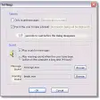Stop spending so much time in front of your computer
Stop spending so much time in front of your computer
Vote: (1 votes)
Program license: Free
Developer: Userhealth
Version: 1.3.4
Works under: Windows
Vote:
Program license
(1 votes)
Free
Developer
Version
Userhealth
1.3.4
Works under:
Windows
Pros
- Encourages regular breaks to reduce health risks associated with prolonged computer use
- User-friendly with an intuitive system tray indicator
- Lightweight and does not require significant system resources
- Customizable break reminders for personalized scheduling
- Ongoing updates that refine user experience
Cons
- Limited to English, which may not cater to non-English speakers
- Primarily designed for older Windows operating systems
Introduction to UserHealth
UserHealth is an innovative Windows application designed specifically to promote the well-being of individuals who spend a significant amount of time in front of their computers. This wellness tool falls within the domain of home and hobby software, with a focus on health maintenance for the digital era.
Key Features and Functionality
At its core, UserHealth is a preventative health application that assists users in managing their time spent on the computer. The software is a lightweight solution for those concerned about the physical strains of prolonged computer use. It conveniently works in the background, tracking active usage time, and suggests breaks to encourage rest and physical activity, thereby combatting sedentary habits.
The application's most striking feature is the system tray icon, which intelligently alters its appearance in response to your active time. This visual indicator serves as a quick reference for monitoring the length of time spent without a break. Additionally, hovering over this icon provides an immediate display of accumulated active time, allowing users to conveniently assess their computer usage at a glance.
One key functionality of UserHealth is its customizable nature. Users can set intervals for break reminders, tailoring the experience to their personal needs or work requirements. This ensures that reminders are not only timely but also relevant to the user's lifestyle. Moreover, the software has been updated to ensure that individual settings are saved accurately, reflecting a consideration for persistent personalization.
Application Performance and Usability
UserHealth's performance on supported Windows platforms is noteworthy due to its modest footprint. It does not demand significant storage space and therefore operates unobtrusively without impeding the performance of other applications. This makes it an accessible choice for users with varied hardware capabilities.
The user interface displays simplicity and ease of use, making it particularly suited for those new to health-focused software. Users can easily navigate through the settings and adjust the program to suit their preferences without feeling overwhelmed by complicated configurations.
Vital Updates and Improvements
The developers of UserHealth have shown a commitment to continuous improvement with updates that enhance user experience. Notable additions include an active time display upon mouse-over in the system tray and fixes to guarantee the proper saving of user-configured settings. These updates suggest an attentive approach to user feedback and a focus on delivering a seamless tool for health management.
System Requirements and Language Support
UserHealth is optimized for users with Windows 98 and earlier versions, though it remains functional on later editions of the Windows operating system. At present, UserHealth is available exclusively in English, which, while possibly limiting its accessibility to non-English speakers, is adequately comprehensive for its current user base.
Conclusion
UserHealth is envisioned as a welcoming wellness companion for the modern computer user. Its straightforward yet thoughtful features strike an essential balance between simplicity and effectiveness, shaping it into a valued assistant for health-conscious individuals at their digital workstations.
Pros
- Encourages regular breaks to reduce health risks associated with prolonged computer use
- User-friendly with an intuitive system tray indicator
- Lightweight and does not require significant system resources
- Customizable break reminders for personalized scheduling
- Ongoing updates that refine user experience
Cons
- Limited to English, which may not cater to non-English speakers
- Primarily designed for older Windows operating systems




